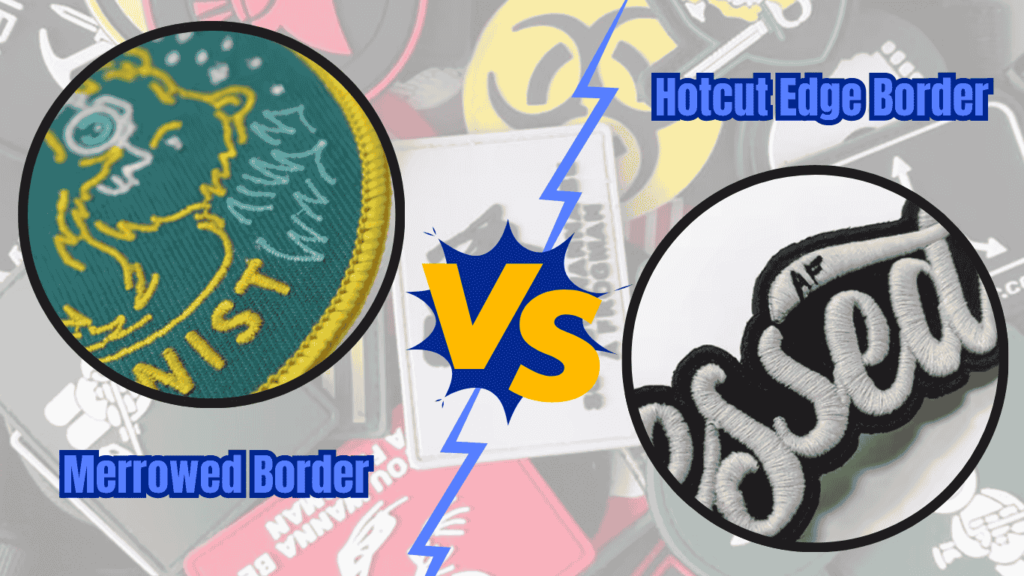
When it comes to custom patches, the type of border you choose affects both the look and durability of your patch. Two popular options are Merrowed borders and hot cut edges. While they may seem similar, each has unique features that make them suitable for different uses.
This guide will break down the differences between these two types of borders, highlighting their pros and cons to help you make an informed choice for your custom patches.
What Is a Merrowed Border?
A Merrowed border is a stitched edge that wraps around the patch’s perimeter. Created with an overlock stitch using a special machine, the edge is thick and durable, offering a polished look and reinforcing the patch’s structure.
Features of a Merrowed Border:
- Bold, Raised Edge: The stitching creates a thick, raised edge that frames the patch. Typically extending about 1/8 inch, it adds visual weight.
- Best for Simple Shapes: Ideal for circular, square, or oval patches. It doesn’t work well for irregular designs due to the stitching technique.
- Added Durability: The reinforced edge helps prevent fraying, making the patch long-lasting.
What Is a Hot Cut Edge?
The hot cut edge is achieved by cutting the patch fabric with a hot knife or laser, which seals the edge to prevent fraying. Unlike the stitched Merrowed border, this method creates a smooth, seamless edge that works well with complex shapes.
Features of Hot Cut Edges:
- Smooth, Flat Edge: The heat-sealed edge is flat, offering a sleek and subtle look. It’s perfect for designs that don’t need a bold outline.
- Great for Irregular Shapes: Hot cut edges are ideal for patches with intricate or unusual shapes, allowing for detailed designs without the bulk of stitching.
- Minimal Bulk: The lack of stitching makes the edge less noticeable and gives the patch a lightweight appearance.
Key Differences Between Merrowed and Hot Cut Edges
Let’s explore how these two types of patch borders differ in more detail:
1. Appearance
- Merrowed Borders: The raised, stitched border gives the patch a bold, defined outline. This traditional look is often used for classic designs.
- Hot Cut Edges: With a subtle and seamless finish, hot cut edges allow the artwork to take center stage without a prominent border.
2. Durability
- Merrowed Borders: The reinforced stitching helps protect the edges, making the patch more durable over time.
- Hot Cut Edges: While not stitched, the heat-sealed edge still prevents fraying. However, the edge may not be as strong as a Merrowed border for heavy-use applications.
3. Shape Compatibility
- Merrowed Borders: Best for basic shapes such as circles, squares, and ovals. Complex shapes are difficult to accommodate with this type of border.
- Hot Cut Edges: Ideal for patches with intricate or irregular shapes. The cutting technique allows for detailed designs.
4. Thickness and Weight
- Merrowed Borders: The stitched border adds thickness and weight to the patch, making it sturdier but bulkier.
- Hot Cut Edges: The absence of stitching gives the patch a thinner, more lightweight finish, which is perfect for delicate or lightweight fabrics.
Which Option Is Right for You?
The choice between a Merrowed border and a hot cut edge depends on your specific needs and the design of your patch.
Choose a Merrowed Border If:
- You want a bold, traditional look.
- Your patch has a simple shape.
- Durability is a top concern, especially for items that will see heavy use or frequent washing.
- You prefer a patch with a raised edge.
Choose a Hot Cut Edge If:
- You need a patch with a complex or irregular shape.
- You prefer a lightweight patch with minimal bulk.
- A sleek, modern design with a subtle edge is your goal.
- You’re working with delicate fabrics.
Combining Merrowed and Hot Cut Edges
For those who want the durability of stitching with the versatility of hot cutting, combining both methods is an option. You can opt for a hot cut edge around the patch’s intricate details and add a stitched Merrowed border where possible, giving you the best of both worlds.
Care and Maintenance for Your Patches
Whether you choose a Merrowed border or a hot cut edge, proper care will extend the life of your patches. Here are some tips:
- Washing: Turn your garment inside out before washing to protect the patch edges.
- Drying: Air-dry your items to avoid high heat, which can weaken both types of borders.
- Reinforcing: If a stitched edge begins to fray, consider reinforcing it with additional stitches. If a heat-sealed edge starts to lift, reapply heat to reseal the fabric.
Conclusion
Both Merrowed borders and hot cut edges offer unique advantages depending on your patch design and application. For simple, bold patches, a Merrowed border provides the durability and classic look you need. On the other hand, if your patch has a detailed or irregular shape, the sleek, subtle finish of a hot cut edge may be the better choice.
At The Supreme Digitizing, we provide both border options to ensure your patches meet your exact specifications. Understanding the differences between these border types will help you make the best decision for your next project.